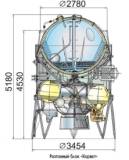|
The Aurora launch vehicle is a Russian designed an manufactured upgrate rocket "Soyuz" capable of delivering satellites to both LEO and GTO. The upgrades include the replacement of the strap-on and stage 1 engines with more powerful RD-107A and NK-33 engines respectively and increasing the diameter of stage one and of stage two. For launches to high orbits, a new upper stage called Corvet is introduced. It is based on the Block-DM. The proposed launch site will be Christmas Island. Asia Pacific Space Centre (APSC) plans to use a new spaceport being developed on Christmas Island, an Australian territory located in the northeast India Ocean. Australia's Asia Pacific Space Centre has joined with Roskosmos, RKK Energya, Samara Central Specialized Design Bureau and Progress Plant (TsSKB Progress) and the Design Bureau of General Machine Building (KBOM). The first commercial launch out of Australia's Christmas Island was planned for the last quarter of 2003. Now the company will commence launch operations in 2006. APSC will commence commercial operations after the conduct of a Test Launch in mid 2004. In excess of nine launches per annum are forecast by 2007. The Aurora launch vehicle is comprised of either three or four stages. The three-stage basic configuration is used to deliver payloads to low earth orbit. The four-stage configuration is used to deliver payloads to high-energy orbits including geosynchronous transfer orbit. Aurora is capable of delivering 4350 kg - 4500 kg to a geosynchronous transfer orbit with an orbit inclination of 10.5 degrees. All four stages of the Aurora LV use liquid oxygen and kerosene propellants, which are both safe to handle and environmentally responsible. Stage-1 includes four boosters that are laterally attached to a core stage. The four boosters are powered by the RD-107A propulsion system manufactured by NPO Energomash. The lateral boosters are derived from hardware used on the highly reliable and man-rated Soyuz launch vehicle. The core stage (stage 2) also has design heritage from other reliable flight systems; its tanks have been stretched to carry 50 tons more useable propellant than previous configurations. The flight control system has been adapted from one used on the Blok-DM upper stage. The core stage is powered by the NK-33 propulsion system. Stage 1 and stage 2 are both manufactured by TsSKB-Progress, a world leader in the production of space launch hardware and booster systems. TsSKB-Progress also supplies the payload fairing. Auroras's third stage is manufactured by RSC Energya. It is a stretched version of a flight-proven Block-I stage. It is powered by the RD-0154 propulsion system and is designed to boost the payload unit (upper stage and payload) to near orbital conditions. The fourth or upper stage, called Corvet, is also manufactured by RSC Energya and is related to upper stages used on other Russian launch systems. The stage is capable of long life in space and multiple engine restarts, and is designed to interface with typical commercial spacecraft buses. The stage uses liquid oxygen and napthyl (kerosene) and is powered by the NPO Veronezh-built 11D58M propulsion system.
|
||
|
|
||


